
An ordinary lawn, of course, cannot withstand the constant load of a standing car. It is easily trampled and loses its attractive appearance. Therefore, for the arrangement of eco-parking, special lawn grids are necessarily used..
They are of two types:
- made of durable frost-resistant plastic, usually green, black or brown;
- concrete, with wider module walls.
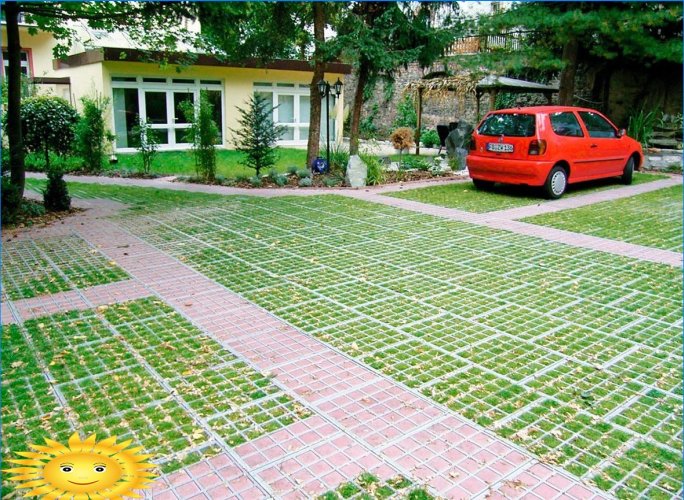
Plastic lawn grates are more popular today – they are easier to install, lighter, manufacturers guarantee a service life of up to 20 years without much maintenance. The shape of the cells of the modules can be different – honeycombs, rhombuses, squares, rectangles. Separate lattice plates are connected to each other with special latches, resulting in an integral base that evenly distributes the load in the form of passing people and cars.
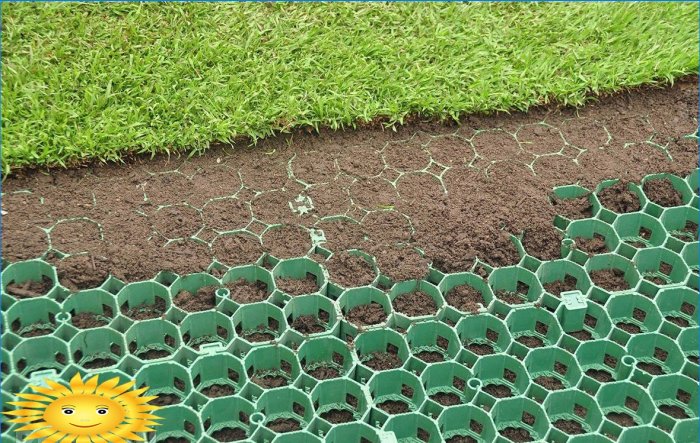
For an adjoining plot where only cars will be parked, a lawn lattice with a height of 40-50 mm is quite enough. Such a coating is capable of withstanding loads from 1.2 to 4 t / m2. Reinforced grilles with additional stiffening ribs are used only where parking is needed for heavy trucks.
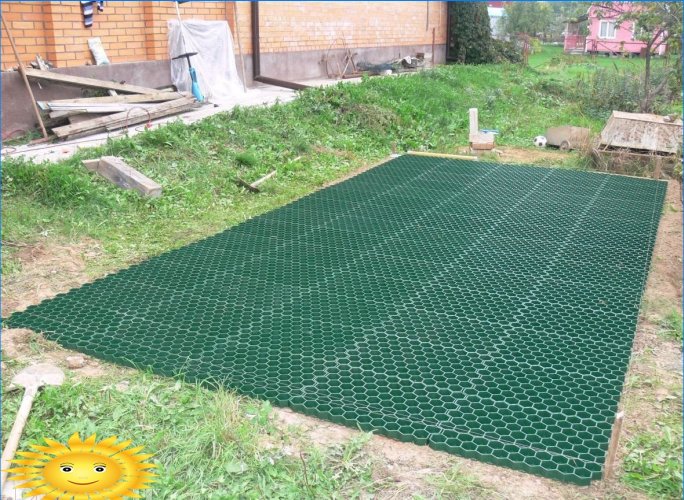
The tasks of the lawn lattice are:
- ensuring the evenness of the entire site;
- preservation of the green cover by protecting the grass root system;
- strengthening the soil, preventing its erosion and the appearance of excavations;
- creating a stable circulation of moisture in the area, preventing the appearance of puddles and flood phenomena.
The grate passes moisture into the soil from above, and from below – a growing lawn, which is protected from external influences. In general, each cell of a concrete or plastic trellis turns out to be a small pot for plants..
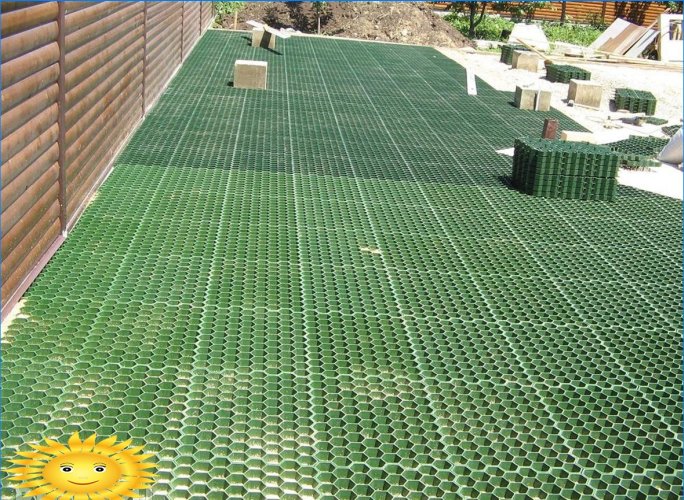
The process of creating an eco-parking includes the following steps:
- cleaning the site, leveling it. There should be no construction debris, plant roots, stumps on the site – nothing that can interfere with making the site even;
- laying the drainage layer. Some manufacturers claim that lawn grids can be placed directly on leveled ground. However, to be sure to prevent puddles, ensure proper water circulation and prolong the life of the coating, a drainage layer should be created. Geotextiles, sand, crushed stone are used. The drainage layer is compacted;
- laying a lawn lattice. Plastic cells snap into place, connecting with each other, concrete ones – just stacked in even rows;
- a layer of fertile soil is poured on top, the surplus of which is removed, all cells must be densely filled with soil;
- the lawn is sown, watering is carried out and in a few days green shoots will appear.
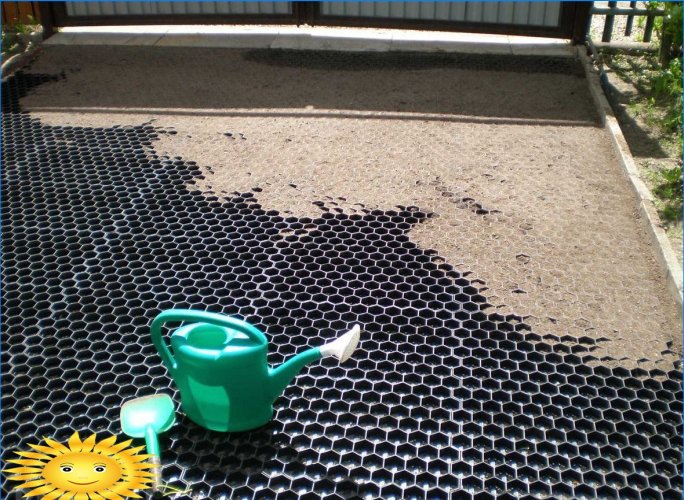
As you can see, the process of creating an eco-parking is not too complicated, it is similar to arranging garden paths and laying paving slabs.
Benefits of lawn grates:
- protect plants from trampling, and the soil from erosion and creeping;
- the density of grass coverage can reach 90% for plastic models with thin walls of modules, for concrete ones – less, but the lawn will still dominate;
- beautiful appearance of the site;
- no puddles, good soil drainage;
- durability;
- ease of care. The lawn in the grate can still be mowed with a lawn mower or trimmer.

However, eco-parking has disadvantages:
- you cannot keep the car in one place for a long time. If a car has been parked for more than two or three days in one area, the grass under it does not receive sunlight, it has no opportunity to recover. Therefore, the green coating will disappear, the machine should be rearranged regularly;
- despite the protective properties of the grill, the grass that protrudes beyond the edges of the modules will simply be cut off about them;
- if the car is leaking oil, gasoline is dripping – the soil will be infected, the grass will die;
- provide a solid foundation, drainage, otherwise concrete slabs or plastic modules will soon sag.
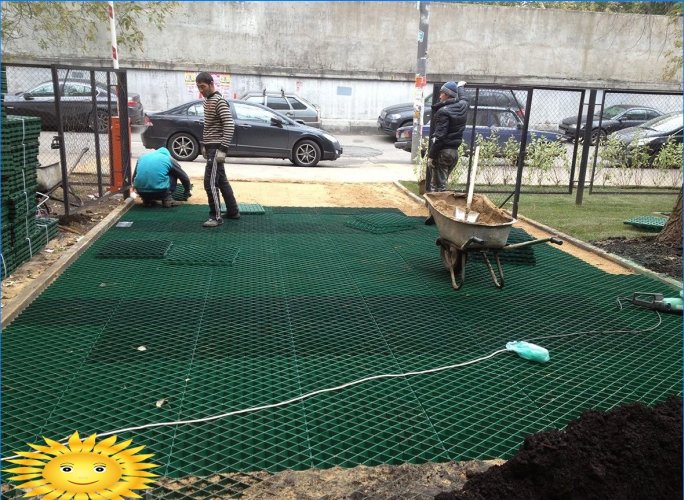
As for the price of a lawn grating for eco-parking, it can be very different, depending on the ultimate load, plastic strength, manufacturer, height. Prices range from 84 to 650 rubles per square meter. A ready-made solution – clearing the site, laying drainage, grating, arranging a lawn – can cost about 2,500 rubles per square meter.

Is it possible to create a space for a car on my property in an environmentally friendly way? What are some DIY eco-parking ideas that I can consider?
I’m intrigued by the idea of a DIY eco-parking solution. Could you provide more information on how to create one? What materials are required, and what environmental benefits does it offer? Additionally, I’m curious if this concept could be adapted for different types of vehicles, or if it’s specifically designed for cars. Any insights or suggestions would be greatly appreciated!
To create a DIY eco-parking solution, you will need permeable materials like gravel or permeable pavers, a geotextile fabric layer, and optional edging materials. This allows rainwater to seep into the ground rather than contributing to urban runoff. Benefits include reducing flood risks, replenishing groundwater, and minimizing pollution. The concept can be adapted for various vehicles, including cars, bikes, or even larger vehicles like RVs, as long as the dimensions and materials are modified accordingly. Factors like weight capacity and slope stability should be considered. Consulting with professionals or researching further can provide more detailed insights and suggestions specific to your needs and location.